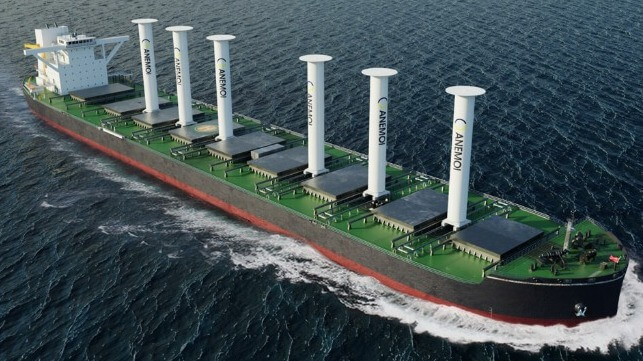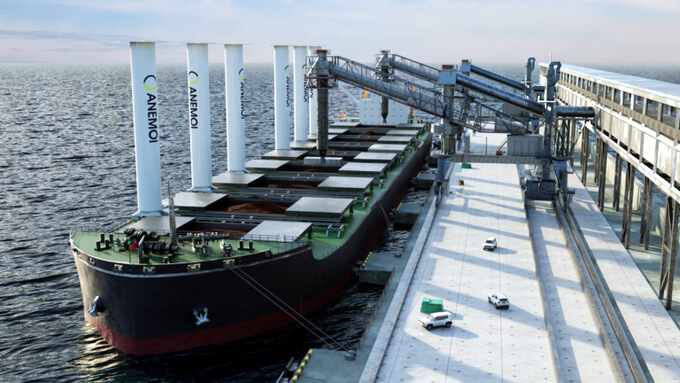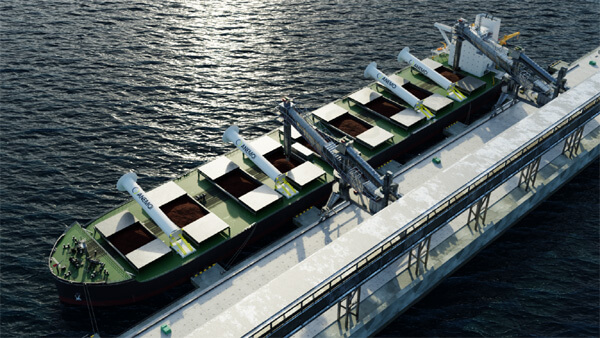Study Validates Significant EEDI Reduction with Rotor Sails on Bulker

A joint research project focusing on enhancing the performance of large cargo vessels is reporting a significant energy reduction resulting in the awarding of its first Approval in Principle from Lloyd’s Register. Launched in 2020, the project is bringing together naval architects with the OEM, ship owner, and classification society to develop a series of energy-efficient vessel designs incorporating rotor sails.
The first project focused on a 210,000 dwt Newcastlemax bulk carrier from Oldendorff Carriers as the shipowner. They studied installing Anemoi Rotor Sails on a newbuild to significantly improve efficiency and reduce environmental impact.
“This collaboration with Anemoi, LR, and Oldendorff demonstrates the great potential of Rotor Sail technology to drive a significant reduction in emissions,” said Wang Gang Yi, Chief Engineer, SDARI (Shanghai Merchant Ship Design and Research Institute) which is leading the project. He said that the results provide ship owners and charterers with available solutions to address environmental goals that also provide regulatory compliance.
The modern version of the rotor sail is comprised of tall cylinders which, when driven to spin, harness the renewable power of the wind to provide auxiliary propulsion to vessels and can reduce overall fuel consumption and lower harmful emissions. Manufacturer of the technology Anemoi has reported that the technology can reduce fuel consumption by between 5 and 30 percent as well as be used in combination with other technologies to further increase efficiency.
In the first phase of the project focusing on the Newcastlemax vessel, Lloyd’s Register assessed the calculation used to estimate the impact the rotor sails will have on the Energy Efficiency Design Index (EEDI). They validated that the vessel would achieve up to a 29 percent reduction on its EEDI through the installation of rotors.
The project measured the impact of employing six rotors standing nearly 100 feet tall over the deck of the newbuild bulker and with diameters of just over 16 feet. They reported the vessel would lower its EEDI score from 1.92 to 1.37 through the installation of the rotors or a 23 percent ) reduction in the score (to 1.47 with the installation of four similar rotors that can also fold to increase the vessels’ clearance and reduce potential obstructions of the cargo operations.


One concept uses rails to move the rotors for cargo handling and the other uses tilting rotors to increase clearance (Anemoi)
“The fitting of Rotor Sails on this bulk carrier, as part of our JDP with Anemoi, SDARI, and Oldendorff Carriers, will considerably improve the vessel’s efficiency and is a clear example of how energy saving devices can support the maritime industry with impending EEXI and CII regulations,” said Mark Darley,
Global Marine and Offshore Director for Lloyd's Register.
Lloyd’s AIP also covers the structural integration for a ship design with six 5x30 meter Rotor Sails and Anemoi’s Rail Deployment System, which sees the Rotor Sails move transversely across the deck to avoid inference with cargo handling. It also includes the structural integration for a ship design with four of Anemoi’s folding (tilting) 5x35m Rotor Sails.
“The results have demonstrated the impressive impact Rotor Sails have on regulatory obligations, which is a key consideration, in addition to the emission reduction benefits. We will continue our assessment of Anemoi’s technology for our fleet,” said Torsten Barenthin, Director of Innovation for Oldendorff Carriers.
The Newcastlemax project is part of a broader joint development project signed in 2020, with Anemoi Marine Technologies, Lloyd’s Register, and SDARI. Other vessels to be included in the project are an 85,000 dwt bulk carrier, a very large ore carrier, a 114,000 dwt Aframax tanker, a 50,000 dwt MR tanker, and a very large crude carrier.
